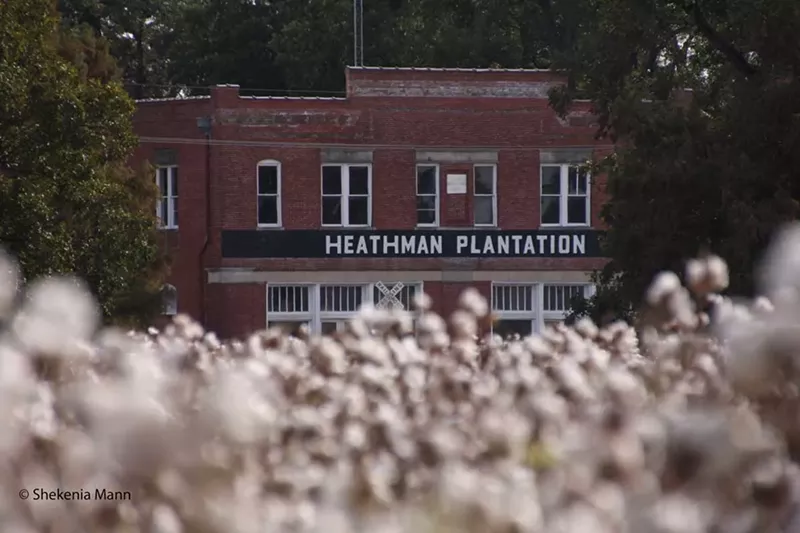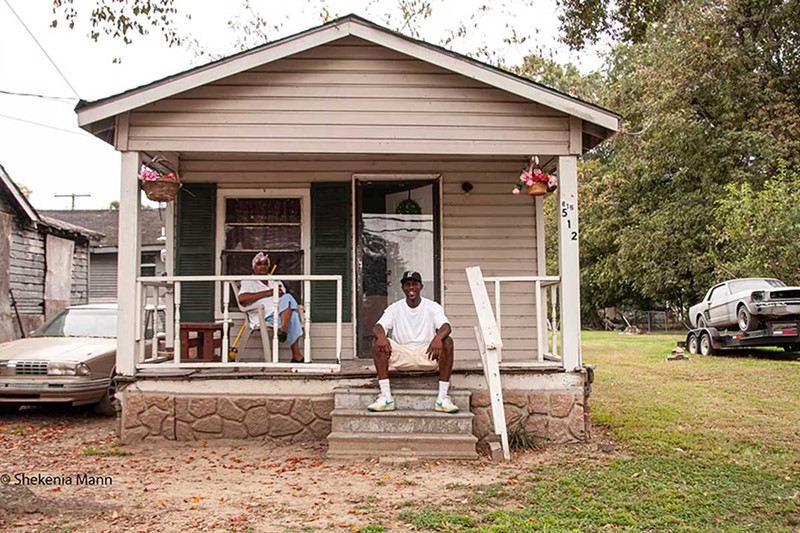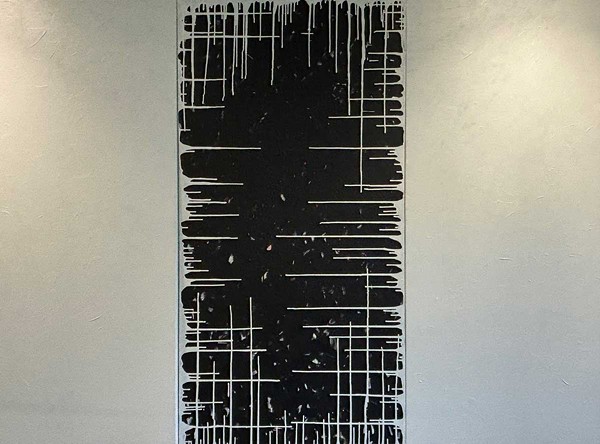A prolific art exhibit is tucked away in perhaps one of the most unassuming buildings on Detroit’s west side.
In the lobby of Northwest Activity Center, a triptych of white paint creeps in on a black center. Lines of chalky white run across the black canvas, inching in from all sides, dripping ever closer to the middle. If it infiltrates the black landscape anymore, eventually, it will cover it completely.
This is part of Yvette Rock’s “Infiltration of Institutional White” series, part of an exhibit called Still in Place at the National Conference of Artists (NCA) inside Northwest Activity Center. Her work is displayed alongside photography by Shekenia Mann in the show, which runs until the end of August.
“I started to think about institutional white as a color swatch,” Rock says. “When you go to the paint store you have different names and colors and so that color, I call it ‘institutional white’ because it’s pervasive and it’s infiltrated the spaces that we’re in historically, and in the present day.”
Rock is a Surinamese-Domincan artist based in Detroit whose family fled to the United States in 1983 to escape corruption and impending dictatorship. She runs the non profit art organization Live Coal and Detroit rePatched — a green space and arts hub in the Brightmoor neighborhood she created on several plots of overgrown land.
Several of Rock’s pieces in Still in Place including “What Comes From Dirt” and “Memory, Migration, and Movement of Black” reference the land she tends in Brightmoor. She was inspired by a photo she took of a pile of dirt on the land, which for her represents a source of life, perseverance, and the “richness of the color black.” The land in Brightmoor that Detroit rePatched’s mobile gallery and studio space sits on was a dumping site and Rock says she struggled with city policies that left her with several tickets for not cleaning the area, which had previously been neglected by the City of Detroit, fast enough.
One time she was fighting a blight ticket when she found a dead woman’s body that was dumped on the property.
“I was literally in court with the city because they ticketed me for, ‘You have too much brush,’ or ‘Why’d it take you so long to clean up?’” she remembers. “I very emotionally described this body that had just been dumped at the same time that we’re getting a ticket and I’m like there’s other things to fight. Why are you fighting me? Shouldn’t we be working together, cooperating to make this a better space for our community? … The policies in place in the city are pretty broken and frustrating. I just don’t want to see this land abandoned.”
She adds, “There’s so much that comes from dirt. Our food comes from there and then there’s this human body put in there… It’s both painful and poetic.”
Further in the series, she flipped the dirt pile over and realized it looked like a boat, holding the ancestral memory of migration whether chosen or forced.
“I started to think about being a political asylee coming from Suriname to America, fleeing and thinking about all those who are either fleeing or those kidnapped,” she says. “So what does this boat start to symbolize? I’m no historian but we know enough to know the grueling pain, the separation, the horrors that took place on boats of our brothers and sisters coming [here].”
Going back to “Infiltration of Institutional White,” the triptych in the lobby with white paint creeping towards a black center is actually a self portrait of Rock.
“It’s the infiltration in my own life by institutional white and institutions that I have given my ideas or brainstormed with [thinking], ‘Oh, we’re doing this together,’ and then at the end I get no credit,” Rock says. “I’m just an example of thousands of Black people that happens to.”
The lobby art is just a tease as more work lies inside the NCA’s gallery. Here Rock paints a series of maps of Brightmoor, once brightly colored, slowly turning more white.
Beside her work sits Mann’s photographs of sharecroppers in the Mississippi Delta picking cotton. They look as if they could have jumped out of a history book page onto the gallery wall, but these are images of Black folks who still choose to pick cotton that Mann shot in 2012.
In one photo of a dense cotton field, a sign reading “Heathman Plantation” looms in the background, linking the not-so-distant past and present.
“For many people in that area, there just isn’t much more for them to do,” Mann says.

Shekenia Mann
In one photo of a dense cotton field, a sign reading “Heathman Plantation” looms in the background, linking the not-so-distant past and present.
Her father worked as a sharecropper back in Mississippi but eventually migrated north. When Mann went to Mississippi for her grandmother’s funeral, she was shocked at her grandmother’s home — which she describes as a shack — but also struck by the area’s natural beauty. But when the photographer told her father she wanted to return to Mississippi to take photos, she was surprised by his response.
“He goes, ‘No baby, those white folks will snatch that camera out of your hand,’ and my stomach turned because you’re talking about this strong man who fishes [and] hunts,” she says. “He goes, ‘Baby, we were sharecroppers.’ …I had no idea. I had never asked him about his childhood. We were millimeters away from slavery.”
Like many Detroiters, Mann’s family came to the city in search of a better life during the Great Migration.
“When you have a vision, or a yearning for something different, it takes the pioneers in the family to get out of those conditions, and to bring others and let them know, hey, there’s something else,” she says.”

Shekenia Mann
Shekenia Mann photographed Black families living in the Mississippi Delta who work as cotton pickers.
Eventually, Mann did make it back to the Mississippi Delta, camera in tow, to photograph Black men in the area who were still working picking cotton.
“I saw brothers and I said, they looked like me. They looked like Detroiters,” she remembers. “They were clean and neat … their jeans were ironed and you could see their shirts were crisp and clean. It reminded me of Detroit. I’m like, this is us. These people are up North too, from the Great Migration. So my thought was, it’s 2012 and we still picking cotton. The only difference is that we’re using cotton pickers to do it.”
The purpose of Mann’s photographs is not to shame people who are still doing this back-breaking work, but to show how some things haven’t changed much in some areas in the South. She says she didn’t ask the subjects in her photos about their working and living conditions and whether they were being fairly compensated, though those are questions the photographs pose. Mostly, she wanted to document their lives and for Black men like them to see their own beauty.
“Look at yourself and see how beautiful and resilient you are,” she says. “See your beauty and your strength, and hear from your ancestors from which [you] came. I think all of us could benefit from knowing where and from whom we’ve come from, because you can draw upon that strength and continue to rise and continue to imagine, and do more and better.”
“Amen,” Rock adds.
Still in Place is on view at the NCA Gallery inside Northwest Activity Center through August; 18100 Meyers Rd., # 392, Detroit. Hours are by appointment.

